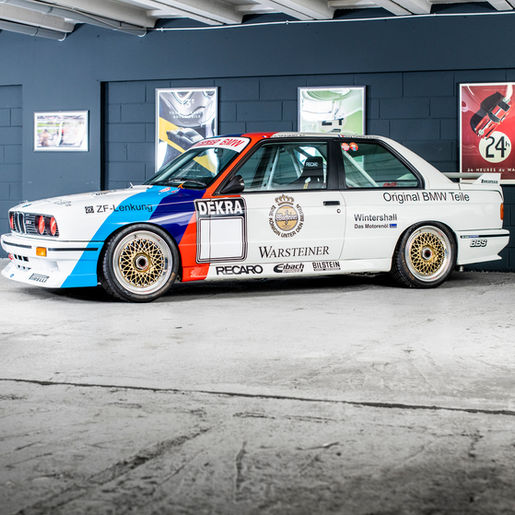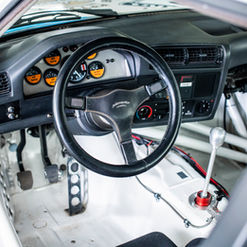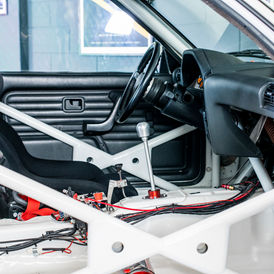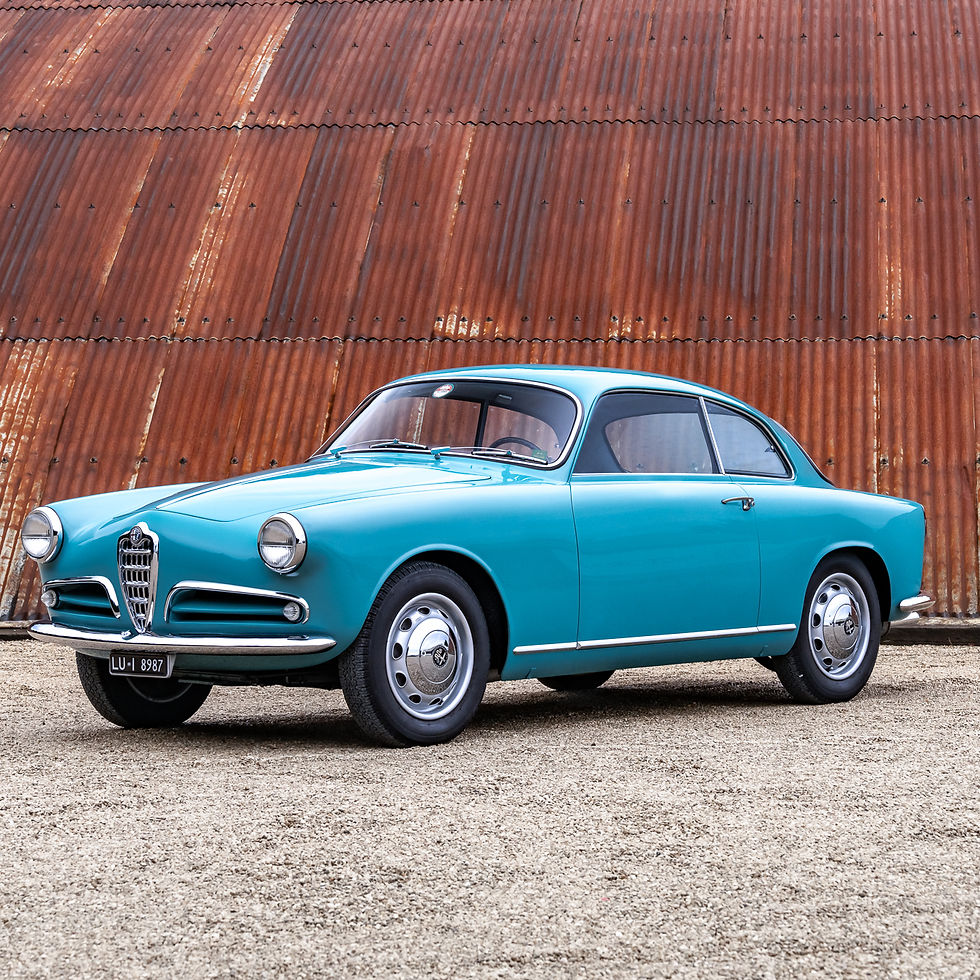In 2020, Gerhard Berger, who has presided over the destiny of the Deutsche Tourenwagen Meisterschaft for a number of years, confirmed that the DTM was abandoning Class 1 regulations and moving to a GT3 format in 2021, based exclusively on private teams. The DTM as a touring car championship, as we have always known it, is therefore dead, even if in recent years the cars have looked more like prototypes than touring cars.
So it's time to look back at the golden age of the DTM, the 80s and 90s.
A unique atmosphere
Frenzied grandstands, singing, flags everywhere, smoke bombs, foghorns blaring to burst eardrums... no, we're not in the stands at a Bayern Munich-Borussia Dortmund match, but in a DTM race at Hockenheim. You might say that it's all the same, because on the famous circuit in Baden-Württemberg, the heart of the circuit is called the Stadium!
The Deutsche Tourenwagen Meisterschaft was founded in 1984 (although it was called the Deutsche Produktionswagen Meisterschaft) by adopting the Group A regulations of the European championship, with private teams. It succeeded the DRM championship, which had enjoyed its heyday in the 1970s with the monstrous Group 5 BMW 320 Turbo, Ford Capri Zakspeed Turbo and Porsche 956, which were closer to prototypes than to production cars (already).
In the inaugural season, the field was extremely varied, with the BMW 635 CSI and 325i, the Rover Vitesse, the Volvo 240 Turbo and the Alfa Romeo GTV all competing. The first race took place at Zolder, Belgium, and the championship was won by Volker Strycek, whose BMW 635 CSi was the first DTM winner in 1984. The first race was held at Zolder in Belgium.
The DTM was fairly permissive in terms of regulations, paving the way for numerous modifications that made the saloons increasingly spectacular and delighted the already renowned tuners such as Schnitzer, AMG, Zakspeed and Alpina.
At the end of the 80s, it was the time of the Mercedes 190 E Cosworth, BMW M3 and Ford Sierra Cosworth RS 500 Turbo competing on the track. Emulation was strong. When BMW brought out its revolutionary M3 in 1987, Mercedes, stung to the quick, retaliated with the 190 Evolution and then the Evolution 2, to which Munich responded with the M3 Evo. 1 tonne and nearly 400 bhp, door slams, jumps on the vibrators, sparks everywhere, it glides, it jerks, it whirs. Kolossal!
The Deutsche Tourenwagen Meisterschaft , or DTM, was beloved by motorsport fans for the monsters that filled its starting grids. European manufacturers such as Volvo, Audi and Mercedes-Benz used the DTM to transform their production sports coupes into true racing machines capable of outrageous performance.
BMW won the DTM twice with the popular E30 M3, with Eric van de Poele taking the crown in 1987 for the Zakspeep team, and Roberto Ravaglia winning it all in 1989 for Schnitzer in an M3 Evo.
Zakspeed in the late 1980s (1987-1989)
Foundation & origin
Founded in 1968 by Erich Zakowski, a car mechanics enthusiast, and based in Niederzissen, a few kilometres from the Nürburgring in the German Eifel region.
Initially renowned for its Ford preparations (Escort RS, Capri, etc.) in Group 2 and Group 5.
Main activities at the time:
Formula 1 (1985-1989)
Zakspeed was one of the few independent teams to build its own F1 engine at the time.
Car: Zakspeed 871/881/891, Zakspeed 1500/4 turbo engine (then naturally-aspirated Yamaha in 1989).
Notable drivers: Martin Brundle, Bernd Schneider, Piercarlo Ghinzani.
Touring / Endurance (DTM, Nürburgring 24h)
Alongside F1, Zakspeed entered BMW M3 E30s in DTM and endurance racing from 1987, with much more solid results.
Cars: BMW M3 Group A, prepared in the Zakspeed workshops.
Drivers: Steve Soper, Dieter Quester Steve Soper, Dieter Quester, Franz Dufter, Markus Oestreich...
Results:
DTM: several podiums, very competitive against Mercedes and Ford.
Nürburgring 24h: 6th place in 1989, best non-official BMW Motorsport M3.
The BMW M3 E30 entered by Zakspeed in the 1988 DTM (Deutsche Tourenwagen Meisterschaft) season is one of the most emblematic touring cars of its era. Designed to dominate touring car racing, the M3 combined agility, reliability and performance in a compact, well-balanced chassis.
Markus Oestreich
A German driver with an aggressive and consistent style, Markus Oestreich raced for Zakspeed in the DTM with this M3 during the 1988 season. He put in several solid performances against fierce competition, notably the Mercedes 190E and the Ford Sierra RS500. Although he did not win the championship, Oestreich scored important points and contributed to the M3's reputation in the championship.
Hockenheim, September 1989.
Light falls softly on the paddock. The air smells of petrol, hot tyres and dust from the transport trucks. The din of the engines has given way to the silence that is typical of the end of a race day: a mixture of pent-up tension and noble fatigue.
At the end of the driveway, leaning against its hydraulic stand, sits a compact car with widened wings. Its factory white is streaked with traces of rubber, chipped insects and paint chips. It's a BMW M3 Group A, but here we only refer to it by its initials: the M3.
A machine like no other
It doesn't have the arrogance of a racing car. It doesn't try to dominate space. It gently imposes its presence. Its look - those familiar round twin headlights - seems more focused than aggressive. Its spoiler, adjusted to the millimetre, doesn't shout. It suggests. It shows nothing, but suggests everything.
A mechanic wipes the bonnet. He doesn't look at it like a machine. He knows it like he knows a horse or an old guitar. He knows that this car has its good days and its bad days. He knows that it likes a clean attack, late braking and long, lean corners. He also knows that it doesn't like rough handling. No sloppy heel-and-toe. No dry transfers. She has to be earned.
The sound of men
A little further on, in the Zakspeed tent, Steve Soper is having a quiet chat with his engineer. They're not talking about engines. They're talking about feeling. About that little flutter at the back as they entered Sachs Kurve. About the hesitation to accelerate again when the rear tyres start to grease. He's not talking about the car as a tool. He's talking about it.
In the paddock, the M3 is a kind of presence. It doesn't just wait for the next round. It inhabits the place. At once discreet and magnetic. An old steward passes by, stops, looks at her, then nods. He must have seen a lot of cars. But this one he respects. A driver for men
It doesn't need a big name to exist. It likes demanding drivers, not showmen. Whether you're Ravaglia or a young hopeful from the BMW school, she treats everyone the same: she'll tell you exactly what you give her. Nothing more, nothing less. Nothing less.
And then there's that noise. That noise. When she slowly pulls out of first gear to go weighing, the S14 engine sputters and then revs up into a metallic, almost raging sound. At high revs, it's like a war clarinet: dry, linear, intoxicating. A soundtrack of discipline. No showboating, no turbo, no panic. Just controlled tension.
Myths are always born in silence
It's in moments like these, when the crowd has gone, that myths take root.
When a silhouette, commonplace to the uninitiated, tells those in the know the story of a whole decade of pure driving, subtle technique and mechanical elegance.
The M3 didn't invent racing. It wasn't the most powerful. It never crushed the competition by sheer force.
But it was the one we listened to, the one we trained, the one we feared - the one we respected.
It's sleeping there now, between two drives, bonnet ajar, still with a little warmth in the sheet metal.
And those who drive by know: this car has said it all. And it hasn't finished talking
Some racing anecdotes about the #33 Zakspeed BMW M3 E30 2.5L DTM (Soper-Quester-Dufter) at the 1989 Nürburgring 24 Hours:
‘Going from turbo to natural’
Steve Soper described the radical change between his turbocharged Sierra Cosworth (~550 hp) and this M3 (~300 hp):
"The difference was huge... You had to keep the momentum and be nice and gentle with it. If you got nervous... she wasn't quick." 
This gentle handling was crucial on the Nordschleife, in order to preserve grip, brakes and reliability.
Local Zakspeed team advantage
Engineer Steve adds:
"We won... because Zakspeed was based at the Nürburgring, literally on the other side of the road. All our development work was done there.
Having a workshop nearby meant that the car could be set up specifically for the northern loop, a major advantage for the race.
Solidity of the S14 unit and thermal chugging
On the M3 E30 race car, the S14 engine had a reputation for being high revving (up to 8,500 rpm). There were frequent episodes of leakage from the exhaust welds:
‘the exhaust pipes were deforming by 25 mm at full load; a simple change of silent-blocks stabilised them’.
The problem was rectified in time for the race, a testament to BMW's responsive engineering.
Old-school cockpit intact:
Despite the extreme preparation, the cockpit remained spartan: analogue dashboard, mechanical gear lever, little in the way of ergonomics, just the essentials in a streamlined cabin around the roll bar. Soper stresses that it was a pure formula: driver, speed and reliability above all.
With this Zakspeed M3, they set the fastest lap in class with a time of 9:29.380.
The BMW M3 E30 is still one of the most revered models in the history of the DTM. Its 1988 Zakspeed version, with Oestreich at the wheel, embodies the pinnacle of German racing engineering in the 1980s, with a car that is balanced, responsive and built for the most demanding circuits.


































































